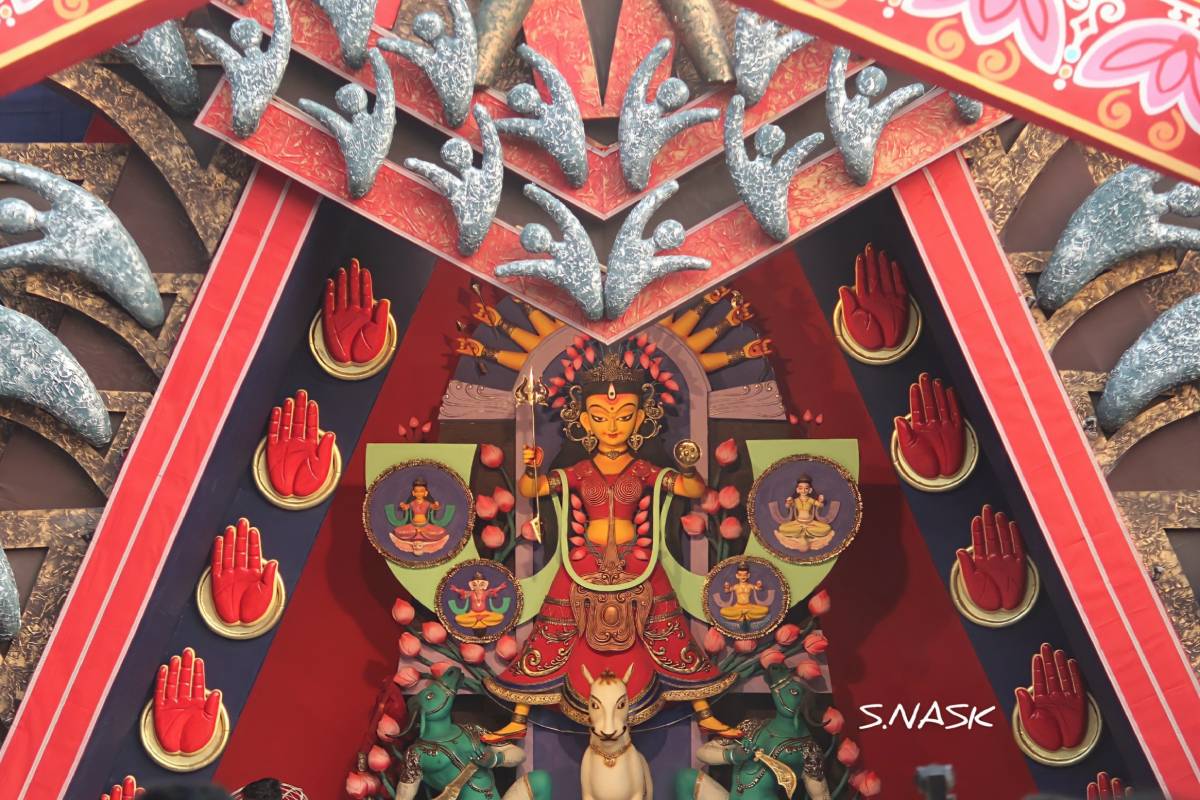“Suddha Suchi, Suddha Ruchi”- a private paint company, before Durga Pujo 1985, raised this small yet catchy slogan to add some inventiveness to Bengali’s greatest festival. The company came forward to give away “Sharod Somman” among the puja committees who would fulfil certain criteria. The slogan and its captivating appeal started to spread like wildfire across Kolkata. Caught by the remarkable concepts of creative flavour, puja committees engaged themselves in something that Bengal never witnessed before. Widely and gradually a healthy competition developed among them.
From the birth of Kolkata, the life of the city dwellers, the culture of its citizens and the history of evolution are closely intertwined. Kolkata and, with the advancement of time, other districts grasped the idea of innovative pandal structures, unique portrayals of idols, spreading social and environmental messages through decoration, sculptures or decors in the pandals. An evolution took place- Bengal and Bengalis beheld the rise of “theme pujo” in the heart of Bengal.
From the mid-90s, the “baroyari pujo” of Kolkata began adapting the form of “theme pujo”. From spreading social awareness to highlighting larger political and international issues, from paying tribute to someone to celebrating historic events – ‘themes’ possess a huge expansion now-a-days. For instance, Kabiraj Bagan Sarbajanin Durga Pujo Committee is all set to recreate renowned singer Krishnakumar Kunnath’s (KK) last concert at Nazrul Mancha, after which he passed away due to cardiac arrest. The Puja committee has felt the necessity to pay a heartfelt tribute to the versatile singer through their theme. According to the local councillor, with whom the authority is affiliated, there will be a statue of KK right on the opposite side of the idol Goddess Durga. The pandal is being made as the replica of Nazrul Mancha. On the other hand, Bhawanipore Durgotshob Committee, through their theme, is paying gratitude to three musical geniuses Lata Mangeshkar, Sandhya Mukhupadhyay and Bappi Lahiri, whose heart wrenching demise creates a hollow in the world of Indian music.
The real essence of the theme, however, lies in the creativity in making the idols and pandal. Barisha Club, in 2020, created the theme “Migrant Mother”, portraying matrirupena Durga, carrying a child, who is actually God Kartika, on her lap. The idol, made by artist Pallab Bhawmik, went viral on social media and was praised by the visitors. On the other hand, Chaltabagan Lohapotty Pujo Committee gave their theme a tribal setting where various natural materials and ingredients were used to make the idols and the pandal. This year also, the puja committees are ready to mesmerize people with their flourishing theme-thinking. Along with or instead of mud, wood pulp, wet cloth, spices, bottles, rice, bran, betel-nut shells, oysters etc. are now widely used ingredients to justify the appeal of theme pujo. From eight to eighty, the use of used plastic bottles, pots, steel glasses, bottle caps and grains in pandals attract every person visiting the pandals.
The craze of theme pujo is felt when a pandal comes from the very beginning of puja. Apart from this, some big budget pujas like Bagbajar Sarbajanin, Park circus, Ekdaila Evergreen and so on are still making people feel the same enthusiasm without moving away from the traditional image of Goddess Durga as if tradition is their only theme. A number of people prefer this ‘conventional and traditional maa’ over theme pujo. Dr Debalina Debnath, professor of Department of Folklore, Kalyani University, in her essay Durgapujo- Ek Roop theke Onno Roop (Durgapujo- From One Form to Another), stated “May our eyes soothe in the mother’s traditional unearthly form, there is pleasure of mind, comfort of soul.” Despite praising the artists for their innovative creations she addresses theme pujo as ‘fusion version’.
There arises an inevitable question- Is the ‘theme pujo’ an insult to the traditional Durga Puja or Goddess Durga? The earliest signs of Durga idols were different from what we see today as the traditional form of the Goddess. Most of these ancient sculptures show the Goddess Durga bare-handed, straddling the throat or tongue of a mahish (buffalo) with one hand and stroking its back with the other. Idols of armed Durga were found in Ellora Caves, Udaygiri and some other places in Central India. It is noteworthy that instead of ten, Devi has four hands here. Another vital thing to note is that there are no human-like asuras and lions are absent as well from almost all of them. Again in some idols of the Pala dynasty, Maa Durga is found as shoroshobhuja (having sixteen hands). Gradually the goddess began to develop into a divine figure to be worshiped as maa (the mother Goddess) in the traditional Bengali joint families. So, the traditional form of idol also came through different stages of evolution.
Change is inevitable. It is the law of time. It is not surprising that Durga Puja is evolving with each passing year. But the real appeal of Durga Puja lies in waiting for the mother for one whole year and finally embracing our own Uma, whether she is portrayed traditionally or as per the modern themes.











